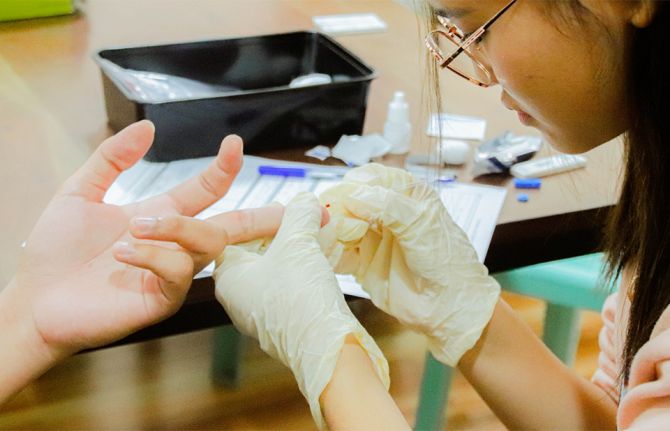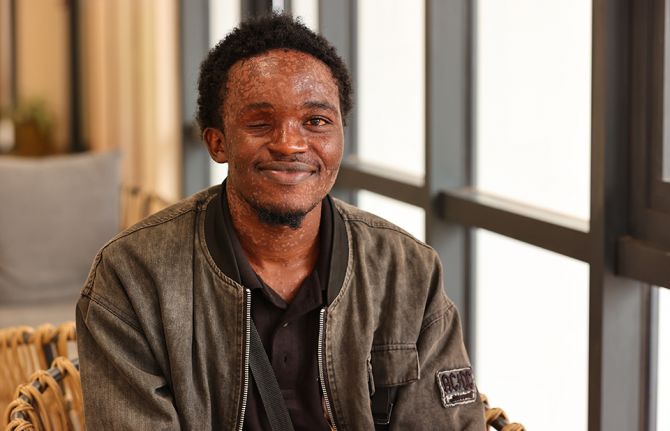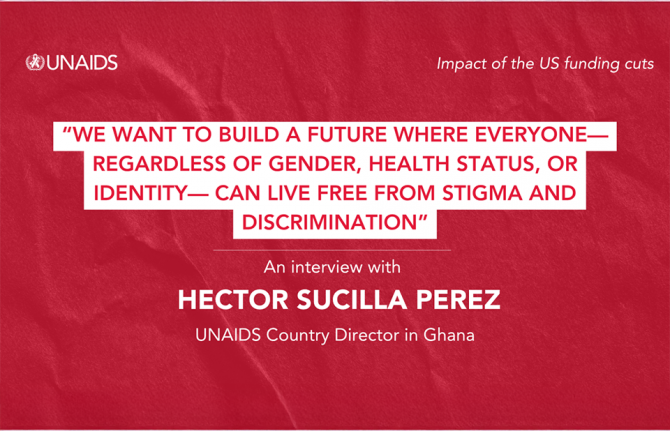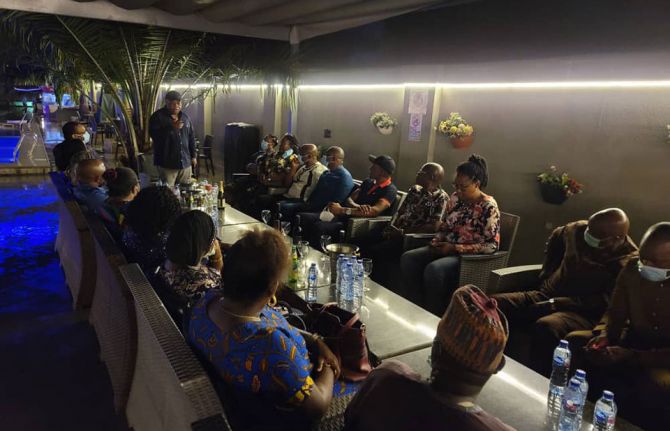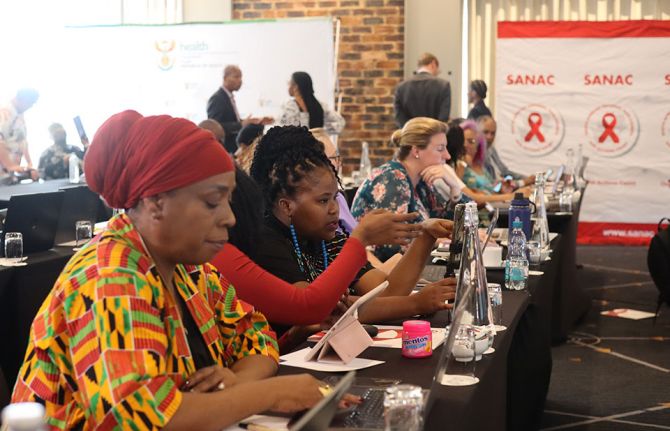
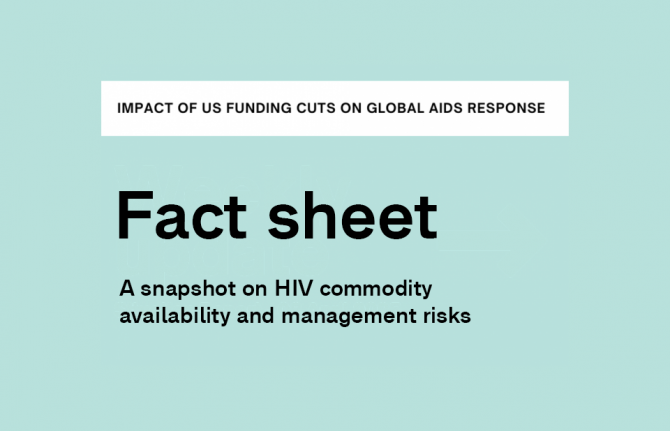
Feature Story
Impact of the US funding cuts: A snapshot on HIV commodity availability and management risks
01 May 2025
01 May 2025 01 May 2025The sudden pause and suspension of US Government foreign assistance has resulted in a multifactorial increase in the risks, challenges, and uncertainty related to HIV commodity[1] availability and management.
The analysis below presents findings from 56 countries (including 100% of PEPFAR-supported countries) which reported on the status of their HIV commodity stocks and supply chains between February and April 2025.[2]
The nature of PEPFAR support is different in all countries, and inclusion in this fact sheet does not necessarily mean that PEPFAR funded HIV commodities or supply chains specifically in that country, nor that all the issues faced are directly attributable to the US funding cuts.
This fact sheet reflects the situation based on information available as of 28 April 2025. Given the rapidly shifting situation, the information presented could change significantly as the situation evolves.
SUMMARY
- Funding for antiretrovirals often comes from diverse sources and their availability and effective delivery to those who need them depends on well-coordinated stakeholder efforts. Some 14% of countries reported six or less months of stock in at least 1 antiretroviral line.
- The degree of public uncertainty and concern over the continued availability of and access to free antiretroviral treatment has increased significantly. Some 18% of countries flagged public reactions to uncertainty, among others changes in individual behavior related to antiretroviral treatment.
- The most frequent variations in antiretroviral dispensation in countries include reductions in multi-month dispensing periods and in dispensing of emergency supplies, restricted switches to alternative antiretroviral regimens, closures of certain antiretroviral treatment dispensing points, and antiretroviral stock redistribution. Authorities have often sought to preempt or respond to rumors and uncertainty by proactively communicating about antiretroviral availability.
- Global Fund existing (or incoming) antiretroviral stocks are helping some countries ensure HIV commodity availability. National authorities are also securing supplementary domestic budget allocations to ensure HIV commodity availability and management.
- Despite the precarious situation faced by many community-led organizations because of the USG shift, they continue to play a central role in engaging and informing communities, addressing rumors, advocating for mitigation actions, and providing early warning on ARV availability, accessibility and cost.
- Significant disruptions affecting combination prevention commodities have been reported as a result of the USG shift. This is due to the dominant role played by PEPFAR in prevention commodity procurement, distribution or delivery in many countries. Some 23% of countries reported six or less months of condom or PrEP stocks.
- Around 21% of countries reported six or less months of stock in at least 1 HIV testing commodity. Careful monitoring of individualized country situations is necessary to mitigate any possible increase in stockout risks.
- Even when HIV commodities exist in-country, they may not always be reaching health facilities – creating patient-facing shortages that undermine trust in treatment continuity. Some 46% of countries reported supply chain management issues.
- The repercussions of the USG shift on the global HIV commodity markets should not be underestimated in the medium term. Sustained predictability in HIV commodity demand forecasts is essential to guarantee a stable supply, maintain prices, and ensure the availability of affordable generic medicines for national HIV responses.
[1] Commodities include ARVs, HIV tests, VL and other lab tests, early infant diagnosis reagents and supplies, as well as prevention commodities (including PrEP and condoms).
[2] The data analysed comes primarily from three sources: 1) Open-text reporting by UNAIDS country offices through the UNAIDS tool “Monitoring HIV Programmes’ Continuity Amidst US Shifts” for the period 5 February – 28 April 2025; 2) UNAIDS country office ad-hoc email updates for the period 18 -24 March and 16-23 April, and 3) UCO / RST consultations with national and regional PLHIV networks on 18-20 March.
Related resources
Related


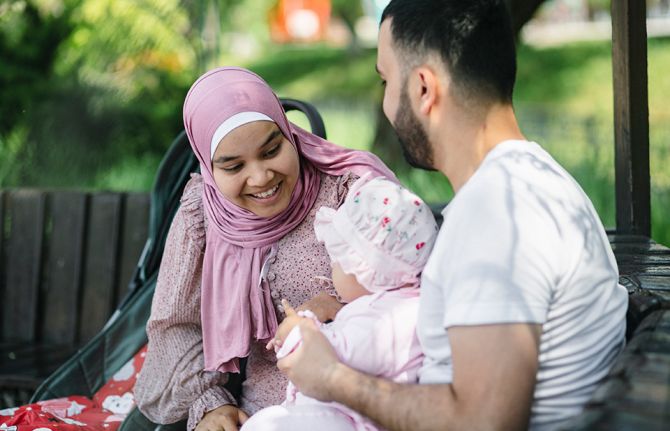
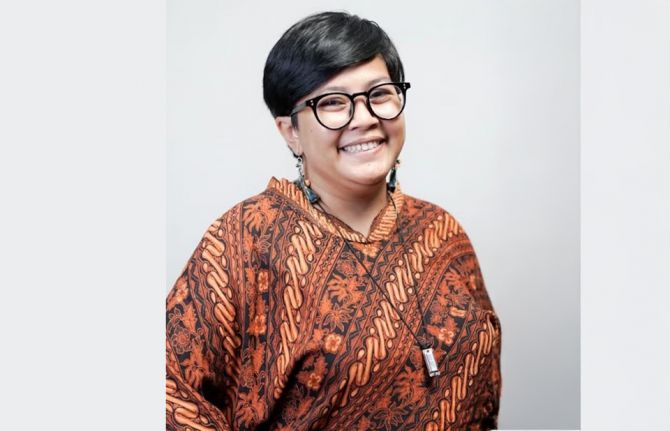
Feature Story
Keeping children free from preventable diseases in Asia Pacific
23 April 2025
23 April 2025 23 April 2025In 2010, at age 23, Ayu Oktariani learned she was HIV positive. Not only did she lose her husband to AIDS, but during her pregnancy her daughter became infected with HIV.
“I had no chance at all to protect my family,” she said. “I had no information about HIV and even less knowledge about HIV and pregnancy.”
Ten thousand children were infected with HIV in Asia and the Pacific in 2023, around 30 every day. Although HIV prevention services helped avoid nearly 72,000 new HIV infections among children since 2015, over one-third of pregnant women in Asia Pacific in need of medicine to prevent HIV transmission to their child, and to keep themselves well, do not have access.
Today, Ms Oktariani and her daughter are accessing antiretroviral treatment and are thriving. In addition, Ms Oktariani now heads Indonesia’s national network of women living with HIV - Ikatan Perempuan Positif Indonesia (IPPI). Through its Emak (mother) Club, IPPI helps women living with HIV to get the information and care that did not reach her and so many others in time.
“We support pregnant women living with HIV to get on treatment, make sure they access maternal and child health services based on their needs and ensure all the babies get prophylaxis (preventative medicines) and Early Infant Diagnosis. We do it with the hope that mothers can give birth to healthy babies, free from HIV,” she explained.
Ms. Oktariani spoke at the launch of the Regional Roadmap for the Triple Elimination of Mother-to-Child Transmission of HIV, Syphilis and Hepatitis B in the Asia and Pacific Region. This resource offers guidance to strengthen national strategies and operational plans to end these three diseases among children by 2030.
The roadmap tracks the progress of 21 countries since 2018. It outlines strategic priorities to pick up the pace, including policy leadership, universal service access, integration with reproductive and child health systems, community engagement and strengthened monitoring.
In the region, Thailand, Malaysia, Sri Lanka and the Maldives have already achieved the dual elimination of mother-to-child transmission of HIV and syphilis. These four countries are also on the way to eliminating mother to child transmission of hepatitis B. Bhutan, Cambodia, China and Mongolia, are also making solid progress, however, other countries still face significant challenges.
The roadmap specifically calls for increased monitoring of syphilis and hepatitis B, and for hepatitis B strategies to be integrated into programmes and policies to prevent transmission.
Sri Lanka eliminated HIV and syphilis in children in 2019 and maintained validation in 2023. It is now on-track to add hepatitis B to the list thanks to continuous work to strengthen maternal and child healthcare.
China launched its HIV prevention programme 24 years ago and has fully integrated these services with maternal and child healthcare. The national rate of mother-to-child HIV transmission is now 1.3%.
In Nepal which has the region’s best overall HIV prevention results, the 2021-2026 National HIV Strategy aims to eliminate these three diseases along with congenital hepatitis C and other sexually transmitted infections.
In the midst of an HIV outbreak, Fiji is developing a Triple Elimination Strategy aligned with global and regional frameworks. It hopes to capitalize on the fact that virtually all its deliveries take place in hospitals.
Papua New Guinea, which also faces rising new infections, is mobilizing resources for its own Triple Elimination Framework. It is currently focused on increasing testing and ensuring women in the provinces access treatment and community support.
At the launch, Regional Directors from WHO, UNICEF and UNAIDS all emphasized the need for integrated services.
“The triple elimination agenda helps us to get the most out of every interaction and investment,” said Eamonn Murphy, Regional Director of UNAIDS Asia Pacific and Eastern Europe Central Asia. “No child should begin life with a disease we can prevent.”

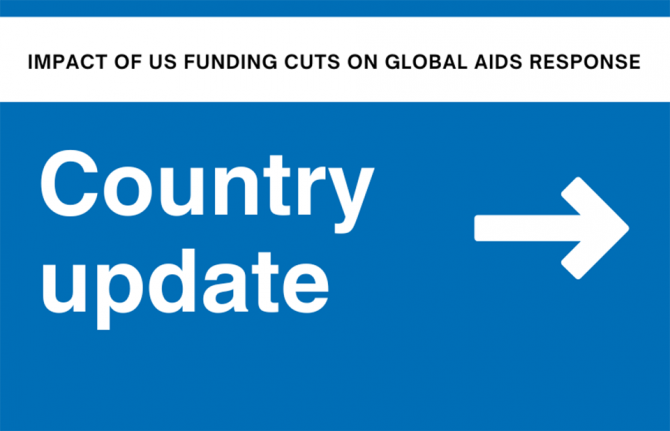
Feature Story
Impact of US funding cuts on HIV programmes in Ukraine
22 April 2025
22 April 2025 22 April 2025Current implementation and disruptions
Documented impact on services
Due to the suspension of US-funded antiretroviral deliveries, critical gaps in ARV availability are expected as early as Q2 2025 for patients in ABC/3TC regimen.
Abacavir/Lamivudine 600/300 mg (ABC/3TC): The availability of the medication is approaching a critically low level. There are potential risks of a shortage of this medicine. The available supply will cover approximately 3.2 months (as of 01 March 2025), which means a stockout is expected by June 2025. The supply under COP23 that included the delivery of 229 packs was blocked. The delivery date to the country is currently unknown.
Lamivudine oral solution, 10 mg/ml (240 ml) 3TC fl: Delivery of 2,364 bottles for children was suspended, with no national procurement planned for 2026. Considering the expiry date of the majority of the remaining stock (June 2026), the treatment coverage is 16 months. The information is provided without considering the use of the medicine for PMTCT.
Nevirapine oral suspension 50 mg/5 ml (100 ml) NVP fl – the supply of 617 bottles is suspended. The treatment coverage with available stock is 15.4 months.
Raltegravir 100 mg (60 tablets) RAL 100mg – supply of 641 packs suspended. At the end of 2024, part of the ARV supply procured under COP23 with PEPFAR funding—579 packs (34,740 tablets)—was distributed to the oblasts. As patient enrollment and treatment optimization progress, the supply coverage will change. Considering the expiry date of the majority of the remaining stock (November 2026), the current supply coverage is 21 months.
Raltegravir 400 mg (60 tablets) RAL 400mg – the distribution of 3,471 packs to the regions is ongoing but will finish soon. Optimization based on treatment regimens using this ARV is underway, and new patients are also being initiated on therapy. Since the expiry date of most of the remaining ARV stock is set for 30 April 2026, the estimated stock coverage is approximately 14 months.
Tenofovir/Lamivudine/Dolutegravir 300 mg/300 mg/50 mg (90 tablets) TLD – In mid-March 2025, 168,397 packs of ARVs (15,155,730 tablets) procured under COP23 with US funding were delivered to the national logistics warehouse. The medicine is currently undergoing inventory control and is being prepared for distribution to the oblasts. The overall national supply coverage will amount to 9.4 months. A buffer stock of 41,273 packs (3,714,570 tablets) remains at the logistics warehouse.
Immediate Risk: Starting from April–May 2025, 193 patients out of 117473 patients on Abacavir/Lamivudine 600/300 mg (ABC/3TC) regime may face treatment interruption.
Collapse of PrEP Scale-Up and Discontinuation of Pilot CAB-LA Programs: In 2025, the PrEP program is at high risk due to halted procurement. The total stock of Tenofovir Disoproxil Fumarate 300 mg / Emtricitabine 200 mg, (TDF/FTC), across Ukraine amounts to 792,240 tablets. Based on the average monthly consumption of 150,346 tablets, the estimated supply coverage of TDF/FTC for PrEP is approximately 5.3 months. A request was submitted for 140,850 packs of TDF/FTC to be funded by the US. However, due to the suspension of US funding, this procurement is currently in question. An urgent procurement of the quantity requested using Global Fund resources is being considered.
CAB-LA: The injectable form of PrEP, CAB-LA, is supplied to two pilot regions: Kyiv and Lviv. The estimated supply coverage is approximately 14.5 months. Immediate Risk: Starting from Q2 2025, the country will likely face inability to initiate new PrEP users among key populations and a disruption in the continuity of prevention for over 13 thousand people already enrolled in the programme.
Breakdown of HIV rapid diagnostics: There is uncertainty about timely delivery of rapid diagnostics tests. Stock balance – 14,823 tests (including 470 tests expiring on 05 June 2025 and 14,353 tests expiring on 08 October 2025). The current stock is expected to last until August 2025. A delivery of 8,480 tests is expected in June 2025.
As of April 2025, the U.S. Government has suspended humanitarian assistance programs, including those funded by PEPFAR, which previously provided essential HIV-related commodities. This suspension has: 1) Blocked planned shipments of antiretroviral medications (ARVs), including major components of pre-exposure prophylaxis (PrEP), 2) Left pending orders under the COP24 procurement cycle in limbo — notably 140,850 packs of TDF/FTC for PrEP, which were to be funded by PEPFAR.
Direct Impact on Service Availability
Disruption of PrEP Services: The uncertainty with procurement for 140,850 packs of Tenofovir Disoproxil Fumarate / Emtricitabine (TDF/FTC) under PEPFAR funding has placed the national PrEP program at risk. The current supply is expected to be exhausted by mid-August 2025, based on average monthly consumption.
No confirmed delivery timeline is available, jeopardizing PrEP continuity for individuals at high risk of HIV infection, PWID, SW, MSM, serodiscordant couples.
Risk of ARV Shortages: Delays linked to the waiver’s absence are contributing to projected shortages of several essential ARVs, particularly:
Abacavir/Lamivudine (ABC/3TC) – with a stockout expected as early as June 2025.
Some ARVs are at risk of expiring before use, due to supply overlaps and administrative uncertainty (e.g., 4,450 packs of ABC/3TC and 8,300 packs of Ritonavir).
Risk to Diagnostics: The current stock of rapid diagnostic HIV tests is expected to last until August 2025.
Government convening, mitigation measures
The Ministry of Health (MoH), through the Public Health Center (PHC), is conducting rapid assessments of ARV, diagnostic, and PrEP stock levels to identify urgent supply gaps. Efforts are underway to reallocate existing stocks from regions with surplus to high-need areas, prioritizing children, pregnant women, and patients on second-line regimens.
The Government of Ukraine, in consultation with partners, is exploring the use of unspent budget lines and Global Fund reprogramming to cover immediate gaps.
The Global Fund Country Coordinating Mechanism (CCM) is actively reviewing budget flexibility for 2025–2026 to prioritize life-saving commodities. UNAIDS to support technically an immediate application by Ukraine to be submitted to the Pandemic Fund for which Ukraine would qualify. WHO and UNAIDS are in dialogue with partners to map regional lab capacity and support logistics to shift patient samples for central testing if needed.
This crisis has accelerated dialogue on transition and sustainability planning, including an appeal to pharmaceutical companies and medical goods manufacturers to explore the possibility of receiving commodities as free humanitarian or charitable assistance.
Civil society impact, resilience and response
In response to diagnostic test shortages, civil society organizations (CSOs) and local healthcare facilities have initiated internal redistribution of rapid HIV test kits purchased with local and regional budgets, as well as other budgetary programs.
Civil society platforms actively pushed for government and international donor action by: Submitting urgent appeals to donors for temporary humanitarian shipments of ARVs and PrEP, Coordinating with Global Fund implementers (e.g., 100% Life, Alliance for Public Health) to track deliveries rapid HIV test kits and PrEP supplies.
UN response
Advocacy for emergency procurement and resource mobilization: UNAIDS and UN partners are supporting national counterparts, including the Ministry of Health (MoH) and Public Health Center (PHC), in engaging international donors to mitigate disruptions in ARV and PrEP supplies.
UNAIDS is working with the MoH and other stakeholders to develop longer-term strategies for transition and sustainability, including Diversification of procurement sources, Programmatic optimization to prioritize high-impact interventions amid constrained resources.
Related resources
Region/country
Related
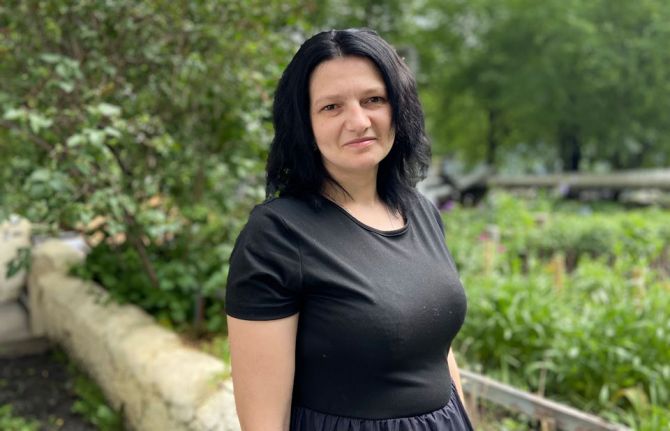 Women, HIV, and war: a triple burden
Women, HIV, and war: a triple burden

12 September 2025
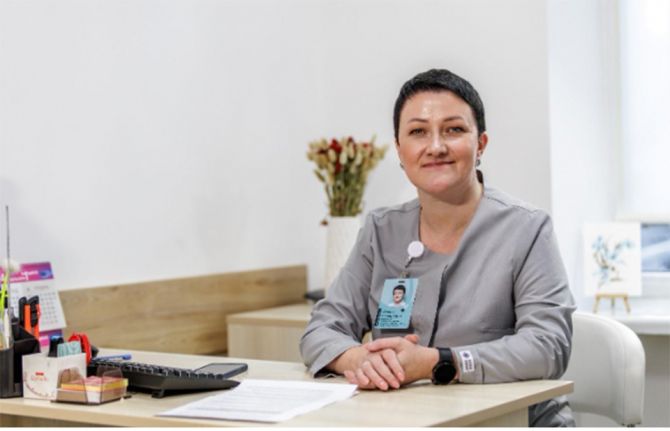 Displacement and HIV: doubly vulnerable in Ukraine
Displacement and HIV: doubly vulnerable in Ukraine

11 August 2025


Feature Story
Impact of US funding cuts on HIV programmes in South Africa
22 April 2025
22 April 2025 22 April 2025Documented impact on services
According to the Department of Health Consolidated Impact Assessment report, the three most impacted provinces regarding HIV and TB prevention services following the US funding cuts are Western Cape, Northwest and Gauteng.
The closure of key population clinics has disrupted access to routine services, including PrEP, and clients have been referred to public health facilities. The DREAMS programme and other services for adolescents and young people have also been impacted, including the mobile outreach services for high transmission areas. According to the International Treatment Preparedness Coalition, the funding cuts could compromise care in non-U districts as decision-makers have limited access to the stock visibility system (SVS) and national dashboards. The mobile application (SVS App) and web management portal (SVS Web) have been used to monitor the availability of medicines and other health commodities at over 3 000 public health clinics and over 300 hospitals since 2015.
Civil society impact, resilience and response
Community initiatives addressing HIV now hang in the balance following funding cuts. Some community-based organizations have been forced to shut down certain programmes while others have stopped operating entirely. These programs provide access to nutritious food in underserved areas, which is vital to improve children's overall treatment. Other programmes include protecting survivors of gender-based and sexual violence through provision of counselling services, HIV preventive medication and safe spaces for women.
Government actions
The Minister of Health, Dr Aaron Motsoaledi, says a new budget allocation to the Department of Health is aimed at addressing longstanding backlogs and rebuilding the country’s strained healthcare system.
The Department of Health will spend ZAR1.4 billion to urgently procure critical medical equipment, including hospital beds and other consumables which have been in short supply across many public hospitals. This is in addition to strengthening healthcare staffing levels at the cost of ZAR 1.78 billion.
Close the Gap campaign
As part of the Close the Gap Campaign, the Department of Health is aiming to reach over 600 thousand men for linkage to HIV treatment. A men’s health clinic in KwaZulu-Natal, launched as a pilot project by the Department of Health has been hailed as a groundbreaking success. Health services provided to men include standard primary healthcare, VMMC, and prostate cancer screening. There are trained male nurses specifically assigned to these dedicated sections. Feedback received indicates that men appreciate the separate space where they feel “seen and heard”. Due to demand, the project has been expanded to five other municipal clinics.
Related resources
Region/country


Feature Story
Impact of US funding cuts on HIV programmes in Malawi
15 April 2025
15 April 2025 15 April 2025Current implementation and disruptions
• Resumption of activities: As of April 7, some CDC-funded partners, including Baylor and Partners in Hope, had resumed their activities. This involves approximately 1,771 staff supported by US funding, supporting HIV service delivery across most districts. The risk that long-acting injectable PrEP might expire has been reduced with the resumption of HIV services.
• Government facilities: Operating at reduced capacity due to gaps in specific human resources for health teams previously supported by PEPFAR, with HIV testing being most affected. The Government has allocated 23.3 billion Kwacha (US$11) million to the Ministry of Health and plans to recruit 6,000 staff covered by the 2025/26 budget to help mitigate the impact of the US funding cuts. The recruited staff will be absorbed into the Government payroll. Transportation of samples is one program area that has been impacted by the US funding cuts. The Government further allocated 3 billion Kwacha (US$1.7million) towards the transportation of HIV samples. • Essential commodities: Most essential HIV commodities, including ARVs, are procured with Global Fund resources, with current funding lasting until 2027. Condom stock levels are sufficient, but distribution, especially among young people, is affected as most NGOs who supported condom distribution have stopped providing services. Cervical cancer screening remains closed and is struggling to restart.
• Emergency areas: A recent assessment of HIV response in climate related disaster emergency prone areas highlighted gaps in the HIV response, including in HIV testing, access to services for pregnant and lactating women receiving services for prevention of vertical transmission of HIV, syphilis and hepatitis services that do not receive multi-month dispensing of ARVs (including outreach service gaps), and programmes to reduce stigma and discrimination. Because of floods, some facilities and hard to replace HIV commodities have been swept away.
Documented impact on services
• Service reductions: The country has seen the closure of centres of excellence and a drastic reduction of service provision affecting service delivery. However, as of 7 April, most CDC-funded partners had been advised to resume implementation of activities, including the NGOs conducting voluntary medical male circumcisions and programs for orphans and vulnerable children (information on which partners is yet to be confirmed).
• The US funding cuts have affected various programmes, including HIV services, supply chain management, malaria programmes, family planning, and maternal and child health services. Some of the services offered by the Government are offered at minimal capacity.
• Early infant diagnosis and paediatric HIV treatment services are affected, with all facilities working at reduced capacity.
• Testing services: HIV diagnostic assistants, supported by US funding, are no longer in service, creating gaps in HIV testing across public facilities.
• Supply chain: Stocks of antiretroviral supplies, HIV, viral load, and other lab test kits are available with minimal disruption in distribution.
• Community services: Community services are also affected, as outreach services were mostly partner-supported. Public facilities are unable to cater for the logistical costs of outreach clinics because of limited funding for fuel or not enough vehicles for transport. This is hampering access to services for hard-to-reach populations and threatens to increase default rates. In addition, 18 drop-in centres with a total cohort of 7,600 patients on antiretroviral treatment and 7,000 continuing PrEP clients are open. It is not clear if the key populations team members who were transitioned to other facilities have come back to the drop-in centres that were closed, affecting service delivery to key populations. Community-led monitoring activities have stopped, and a few are starting with support from the Global Fund, Gates Foundation and GIZ.
Human rights and key populations
• Stigma and discrimination: The US funding cuts have exacerbated stigma and discrimination faced especially by key populations members who are often blamed by the wider community for the US’ withdrawal of funding. Community members fear the cessation of antiretroviral therapy provision - and negative attitudes towards them.
• Advocacy and programming: Reduced capacity among civil society organizations to continue advocacy for domestic funding and programme design, particularly for key populations.
Politically relevant updates
• Government convening: A country-level task team, including representatives from people living with HIV and key population networks, is discussing the impact on service delivery, and identifying mitigation measures.
• National AIDS Commission: The National AIDS Commission was leading the design of development of standard operating procedures for key populations, but due to the US funding cuts, this process has halted.
UN response
UNAIDS is providing technical and financial resources to assess the HIV response during emergencies in disaster-prone districts, including the impact of the US funding cuts, to inform disaster preparedness and response intervention. The assessment was completed on April 5, 2025.
It has also developed a five-year UN Joint Programme of Support to the Government of Malawi to help highlight crucial prevention and treatment interventions the Government should prioritize to help end AIDS in Malawi.
Related resources
Region/country
Related


Feature Story
Impact of US funding cuts on HIV programmes in Angola
15 April 2025
15 April 2025 15 April 2025Immediate risks and disruptions
- Loss of PEPFAR support:
- The community outreach programme is on hold while clinical services continue in the 22 clinics supported by PEPFAR (out of 880 clinics nationally providing ART) across the 4 provinces out of 21 in Angola.
- Across the country, facilities/service points delivering antiretroviral treatment are working with the same capacity. While stocks of antiretroviral supplies, HIV, viral load and other lab test kits are available, recent reports indicate challenges with distribution.
- Logistics disruptions have led to facility-level stockouts of HIV commodities, despite stock being available in regional warehouses.
- The purchase of condoms by INLS and partners, including PEPFAR and the Global Fund, has historically covered only half of the estimated need due to resource limitations. A national condom strategy is currently under development.
- PEPFAR distributed condoms in the 22 clinics they support and via outreach programmes, which are now on hold.
- There has been a disruption in the PEPFAR data collection system. Data for Q4 (September-December 2024) is still being collected and analyzed due to a lack of human resources to support DHIS2 (health logistics data) reporting. Eighteen PEPFAR-supported sites are included in the Estimation and Projection Package Spectrum model for calculating HIV incidence; however, PEPFAR antenatal care testing data was not available to serve as a benchmark against the reports submitted in DHIS2.
- Angola received PEPFAR funding for work on community-led monitoring. This has been terminated.
- PEPFAR support for stigma, discrimination and enabling legal environments has stopped.
- Government mitigation measures:
- The Government has planned mitigation measures for each of the PEPFAR programme components. The plan indicates that the national budget is suggested to cover testing, treatment and laboratory consumables, while it is suggested that community programmes should be supported by public and private institutions.
Documented impact on services
A rapid assessment of the impact of the US funding cuts on service delivery is available. As outlined by the Institute for the Fight Against HIV/AIDS (INLS), the greatest impact of the loss of US support in Angola will be felt in the quality of services, as indicated below:
- Peer education for adolescents and youth:
- In 2024, PEPFAR supported training and mentoring for 467 health professionals creating mutual support groups and peer-to-peer programmes for adolescents and youth.
- Prevention of vertical transmission of HIV:
- As of September 2024, 1,163 pregnant women living with HIV were enrolled in a programme to prevent vertical transmission of HIV in 22 health units supported by PEPFAR.
- Community support programmes for treatment, adherence and psychosocial support are on hold.
- Early infant diagnosis:
- In addition to support for early infant diagnosis in the 22 health units covered by PEPFAR, the community component of PEPFAR supported a pilot to collect blood samples in the community, which led to an increase in early infant diagnosis from 36% to 88% in health units supported by PEPFAR. The loss of community outreach undermines these lifesaving efforts.
- Clinical management for people living with HIV:
- PEPFAR supports about 6% of HIV tests in the country.
- As of September 2024, 3,609 people were newly identified as HIV-positive, with 84% enrolled on antiretroviral treatment (ART). Without US funding, lower case identification will occur, increasing the risk of transmission and health complications.
- By 2024, a total of 26,999 people living with HIV were on treatment at PEPFAR supported sites, representing about 16% of people on ART across the country
- In addition, active community outreach ensured that out of 1,007 people who interrupted treatment in the third trimester of 2024, 707 (70%) were successfully re-enrolled in treatment;
- Only in places where there is support from PEPFAR or the Global Fund (Benguela, Bié, Cuanza Sul, Huambo and Lunda Sul), is systematic community engagement effectively implemented (focused on pregnant women, children and high-risk young people); the backing of mutual support groups of people living with HIV; the provision of psychosocial support for enhanced adherence to HIV treatment, information, education and active communication on HIV prevention, including the distribution of condoms and community based testing and linkage to services.
- Strengthening the health system:
- PEPFAR has facilitated training and capacity building for HIV health workers, improving local health systems.
- Support for data collection and monitoring has reinforced health systems and enabled data-driven decision-making.
- PEPFAR is the only program that supports the evaluation of the quality of diagnosis, increasing the accuracy, effectiveness and quality of HIV testing services in the country.
Politically relevant updates
- Government convening and mitigation measures:
- The National Institute for the Fight Against AIDS (INLS) has developed a mitigation plan, proposing the national budget cover clinical staff and medical inputs for users of 13 health units supported by PEPFAR.
- Resource mobilization from public and private institutions is identified to cover community engagement and programmes.
- INLS is coordinating the mitigation measures with the Ministry of Health and the CCM.
- Civil society impact:
- Community Led Monitoring programmes have been terminated.
- Community outreach programmes, including those for youth, pregnant women, and people living with HIV, are on hold.
- Civil society organizations are struggling, and while some have alternative funding sources, most organizations are unable to continue their planned work.
- UN response:
- UNAIDS has met with networks of people living with HIV and key populations to assess emerging challenges and discuss mitigation measures.
- In collaboration with Government and civil society, plans to develop national approaches to PEPFAR-supported community-led models are underway.
Related resources
Region/country
Related


Feature Story
Impact of US funding cuts on HIV programmes in Lao PDR
14 April 2025
14 April 2025 14 April 2025Immediate risks or disruptions
- Impact on cooperative agreements:
- WHO-US CDC cooperative agreement: The WHO-US CDC cooperative agreement has been significantly impacted, particularly in provision of technical assistance to expand point-of-care services, expanding pre-exposure prophylaxis services, strengthening strategic information systems, capacity-building through training, workshops, and seminars, as well as travel and human resources-related costs.
- Ministry of Health cooperative agreement: The HIV department is partially impacted, with some planned activities not receiving full US Government approval or funding. The US funding cuts have significantly impacted maternal and child health programs, the original $400,000 commitment per year was reduced by more than 50%. This reduction has led to major challenges in capacity-building efforts, limited training opportunities for healthcare providers, and reduced plans for integrating maternal and child health services into point-of-care sites.
- WHO cooperative agreement: Fully affected, disrupting all planned activities under their Direct Financial Cooperation agreement with the government. This includes efforts to strengthen laboratory service quality, improve strategic data reporting and cover human resource- related costs.
- Service delivery:
- Routine HIV services at antiretroviral therapy sites and points of care remain largely unaffected due to the national programme’s continued provision of regular HIV testing and antiretroviral care.
- However, the US funding cuts have disrupted HIV prevention programmes, particularly those supported by PEPFAR through USAID/FHI 360 and WHO-US CDC. This has led to delays or disruptions in community-based HIV outreach programmes.
- Community impact:
- Eight staff members from the Association of People Living with HIV across 12 operational provinces will lose their jobs, further impacting service delivery and community support efforts.
- Community-led organizations have experienced a reduction or suspension of services, loss of funding, and loss of staff, reducing their ability to collect and report data and limiting their ability to reach out into the communities to provide HIV prevention services.
Politically relevant updates
- Government and international response:
- The Global Fund to Fight AIDS, Tubercuosis and Malaria (Global Fund) and the United Nations have advocated for the government to fully access and optimize the Health and Nutrition Services Access Project (HANSA) grant and loan components to bridge gaps created by the US funding cuts.
- Communities have approached the French funding mechanism L'Initiative from Expertise France to help close funding gaps.
- The UN Country Team has mapped the funding gaps and has started quantifying the reduction from the United Nations Sustainable Development Cooperation Framework (CF) as a result of the decrease in overseas development assistance. Eleven of the CF’s 21 outputs have been affected by funding reductions. Programmes affected by funding reductions account for more than a quarter of expected available funding in 2025. Outcome 1 (including Health, Nutrition and Food Security) has the most funding at risk of reduction. Outputs in Outcome 3 (Governance and Rule of Law) see the largest proportional reduction in funding.
- UNAIDS has supported the government in mapping the gap caused by the US funding cuts and has shared a report with the Global Fund and other development partners.
- UN Joint Team has mapped the impact on the Joint Programme. While the UNAIDS Cosponsors are looking for stop-gap measures to cover the gaps in the short term, the US funding cuts are expected to significantly reduce the UN’s contribution to the HIV response in Lao PDR. Since the US was the sole donor to UNODC’s health program in Lao PDR, this will result in the suspension of all UNODC health-related activities in the country as of May 1, 2025.
Civil society impact, resilience and response
- The Community-led monitoring for key populations project, implemented by the Association of People Living with HIV and supported by USAID/FHI 360, operates in Vientiane Capital, Savannakhet, and Champasak provinces. This initiative enhances community engagement among men who have sex with men and transgender individuals, strengthening their capacity to address their own health challenges while fostering trust and collaboration between communities and healthcare providers. This project has significantly improved health outcomes and reduced stigma. However, the suspension of this project is expected to hinder the expansion and scale-up of HIV community led monitoring across all key population services. The loss of eight staff members from the association of people living with HIV across 12 operational provinces will further impact service delivery and community support efforts.
- Despite these challenges, some community-led organizations are managing to sustain efforts through alternative sources of funding, demonstrating resilience and adaptability in the face of funding cuts. However, these measures may not be effective beyond 2025 and will result in weakening the inclusion of community-led efforts in the HIV response.
Related resources
Region/country
Related


Feature Story
Impact of US funding cuts on HIV programmes in Lesotho
14 April 2025
14 April 2025 14 April 2025Immediate risks or disruptions
- Vertical transmission services: An impact assessment conducted by the Ministry of Health, supported by UNICEF, confirms:
- Staffing gaps and shortages: There are significant staffing gaps affecting the availability of counsellors and other essential personnel.
- Testing disruptions: HIV testing services are disrupted, with specific issues such as a non-operational point-of-care machine in one district.
- Overcrowding: There is overcrowding in health facilities across all 10 districts due to staff shortages.
- Data quality issues: Data completion and quality are severely impacted as nurses struggle with using the registers.
- Resource allocation: The field assessment highlights the need for reprogramming of, and additional, resources.
- Service restart challenges:
- Partners who received waivers to restart services are facing difficulties in resuming operations effectively.
Politically relevant updates
- Government actions:
- A national resource mapping exercise has been launched by the Ministry of Health to guide reprogramming within the health sector. This exercise aims to provide a detailed understanding of available resources to support broader health sector interventions.
Related resources
Region/country
Related


Feature Story
Impact of US Funding Cuts on HIV Programmes in Côte d'Ivoire
09 April 2025
09 April 2025 09 April 2025Immediate Risks and Disruptions
- The US waiver allowing the continuation of lifesaving treatment and the court order allowing CDC-led activities to resume resulted in the resumption of the provision of antiretroviral treatment (ART) and prevention of vertical transmission of HIV.
- Activities for key populations, HIV-prevention, human rights, and community-led monitoring (CLM) have ceased.
- Contracts providing support to national civil society organizations (CSOs) have been terminated. National implementing partners like Espace Confiance, ASAPSU, and Blety ceased all activities supported by the USAID in March.
Politically Relevant Updates
- Government actions:
- The government has requested a rapid analysis of the financial gap following the cessation of US funding (internal report not yet available).
- The Ministry of Health issued a directive on service continuity, ensuring access to ARV care and other services.
- An antiretroviral order planning meeting has been held. ARV stocks have been secured for the next 4 months and an order schedule for the remaining part of the year has been agreed.
The CIPHIA (Côte d'Ivoire Population-based HIV Impact Assessment) survey has resumed, with final report availability expected by the end of September 2025.
- Civil Society Response:
- Civil society organizations have launched an advocacy campaign, including a letter to the president, press conferences, and media interviews calling for continued support and funding for HIV programmes, including sustainable financing of civil society and community-led responses
Temporary measures have been implemented to maintain services and staff in certain NGOs, including minimal service, part-time contracts, and salary reductions. However, these measures cannot be sustained in the absence of additional funding. CSO are working on developing funding proposals.
- UN Involvement:
- The UN has met with civil society and is in ongoing dialogue with CSOs re the impact and mitigation measures.
- UNAIDS has produced and shared short videos of interviews with community leaders and beneficiaries; they have garnered more than 4000 views on social networks.
- Government officials have been informed, sensitized, and mobilized on the impact and the need for a coordinated and systematic response. This included using UNAIDS GOALS impact model on new HIV infections and HIV related deaths in absence of a comprehensive response.
- An analytical technical note on the impact of the US funding cuts and recommendations for mitigation strategies was produced and shared with government officials.
- The UNAIDS Rapid AIDS Financing Tool (RAFT) has been shared and promoted with various government offices, including the Directorate General of Health, Directorate of Health Economics, National AIDS Control Program, and the prime minister's office.
- Resources have been mobilized from various sources to ensure the continuation of critical UNAIDS activities: Expertise France for technical assistance on the sustainability roadmap, reprogramming of CDC cooperation agreement activities for approximately 150,000 USD (Expertise France, BMGF, GF/GC7 grant).
Related resources
Region/country
Related


Feature Story
Impact of US funding cuts on HIV programmes in Ghana
08 April 2025
08 April 2025 08 April 2025Commodity stock report
The commodity stock report elaborated by the Ghana Health Services/Ministry of Health under the umbrella of the Global Fund Logistics Support Project, provides insights into the national availability of key HIV and other health commodities. The recently released information for the month of February contains the below mentioned information on the availability of antiretroviral treatment and other HIV commodities.
- Antiretroviral treatment:
- Tenofovir/Lamivudine/Dolutegravir (TLD 300/300/50mg): Fully available nationwide with a slight overstock - 12.85 months of stock.
- Dolutegravir 50mg: Fully available with overstock – 18.19 months of stock.
- Tenofovir/Lamivudine (300/300mg): Overstock - 41.62 months of stock
- Lopinavir/Ritonavir (200/50mg): Fully available with overstock - 17.83 months of stock. Nevertheless, there is only 64% availability across regional medical stores, with stockouts in Ashanti, Bono and Bono East regions. Distribution to these regions aims to stabilize supply.
- Dolutegravir 10mg: Adequate stock - 10.85 months of stock with 91% availability at regional medical stores and teaching hospitals. Allocation and distribution measures aim to stabilize supply.
- Abacavir/Lamivudine (120/60mg): Critically low stock levels at 1.22 months of stock with 64% availability at regional medical stores; new shipments are pending clearance.
- Paediatric and syrup formulations: Zidovudine/Lamivudine tablet stock is high (25.27 months of stock). Nevirapine syrup is fully available (6.38 MoS), there are lower stock levels of Zidovudine syrup (3.17 months of stock), with an incoming shipment expected.
- HIV and syphilis diagnostics:
- OraQuick HIV test kits: Availability improved from 91% in January to 100% in February (4.93 months of stock).
- HIV first response & syphilis combo test kits: Consistently at 100% availability (6.45 and 9.54 months of stock respectively).
- Rapid diagnostic tests SD bioline: Stockouts in Ashanti and Bono, with critically low in-country stocks (0.87 months of stock). A shipment of 75,240 kits is expected in April 2025.
Politically relevant updates
- Ghana Medical Trust Fund: The Government of Ghana has launched the Ghana Medical Trust Fund (Mahama Cares Initiative). This presidential initiative, launched in mid-March, aims to provide financial support for people with chronic diseases. The Ghana AIDS Commission (GAC) and the UNAIDS Country Office have initiated discussions to potentially include HIV as one of the health conditions to be covered by this mechanism. This alternative has been also included as part of the options to explore in Ghana’s Sustainability Roadmap document. UNAIDS is providing support to the GAC to amend the terms of reference for the HIV Sustainability Technical Working group to include the documentation of the impact of US funding cuts as part of the mechanisms to streamline the coordination, monitoring and mitigation of the situation.
- Human rights steering committee meeting: On 26 March, the Ghana AIDS Commission convened the 7th Human Rights Steering Committee Meeting, chaired by the Acting Director General. The meeting included key national and international partners, including UNAIDS, to advance the human rights agenda within the HIV response. The Committee recommended strategic engagement with the PEPFAR Coordinator to get accurate programmatic and financial information on human rights-related interventions supported by the US.
- Courtesy visit from PEPFAR team to the Ghana AIDS Commission: On 3 April, a PEPFAR team delegation led by the PEPFAR Coordinator for West Africa II Region (Ghana, Liberia, Sierra Leone, and Mali), paid a courtesy visit to the Acting Director of the Ghana AIDS Commission and his team. This was the first official meeting of the PEPFAR Team with the Ghana AIDS Commission since January. Initial discussions on the relevance of PEPFAR’s support to the HIV response in Ghana took place.
- Bilateral Meeting UCD-Ghana and PEPFAR Coordinator for West Africa II: On 4 April, a bilateral meeting was held at the UNAIDS country office between the UNAIDS country director and the PEPFAR Coordinator for West Africa II Region (Ghana, Liberia, Sierra Leone, and Mali). The iscussion focused on the critical need to maintain US support in Ghana to ensure programmatic sustainability, to achieve the 95-95-95 and 10-10-10 targets, and to continue the collaboration in support of the process led by the Government of Ghana to develop the HIV Sustainability Roadmap.
Coordination with Civil Society Organizations and communities.
On 3 April, UNAIDS Country Office initiated a series of bi-weekly meetings with community-led organizations to assess the impact of the US funding cuts on their work, including their focus on human rights, stigma and discrimination, and HIV prevention. The community-led organizations agreed to design a tool to map out the projects previously funded by the US Government that have stopped and to find alternatives to close the gaps and maximize efficiency in the delivery of programmes.


